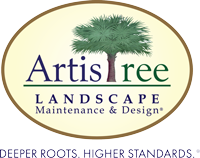Q&ARTISTREE: HOW DO YOU KEEP SPIRALING WHITEFLIES FROM SPIRALING OUT OF CONTROL?
Q: We hope you can help us out, ArtisTree. We have a new pest, and it’s not our neighbor. Little white flies have decided to take up residence in our palms and bushes. Can you tell us what they might be and if we should be worried about an infestation?
A: Well, at least you have a nice neighbor. Sounds like you have Spiraling Whitefly, not to be confused with ficus whitefly. Spiraling whitefly is a large, slow-moving pest which can infest any number of plants and palms. Some of its favorite hosts are gumbo limbo, palms, live oak, black olives, cocoplum and wax myrtle, among others.
The most noticeable symptoms of an infestation of this whitefly are an abundance of white, waxy material covering the leaves, eggs laid in a spiral pattern on the host plant leaves and excessive sooty mold, which is the insect’s excrement. Originally called the gumbo limbo whitefly, it is now named the rugose spiraling whitefly and it was first found in Miami in 2009. Scientists believe it originated in Central America.
Spiraling whitefly feeds by inserting its mouthparts into the plant cells and sucking out the sap. The sugary sap rapidly moves through the whitefly dropping onto anything and everything. Many experts contend spiraling whitefly is a nuisance pest which creates a mess but does not kill the host plant. In general, whiteflies can cause plant decline, defoliation and branch dieback.
Treatment for this pest can be as simple as using a strong stream of water to wash the whiteflies away. Large palms and trees may require treatment with a pesticide applied as a drench to the roots or injection in the trunk. Work with your landscaper or pest control professional to determine the best treatment for your landscape.

Category Pests
Tagged with: branch dieback, landscape maintenance, pests, sprialing whitefly


